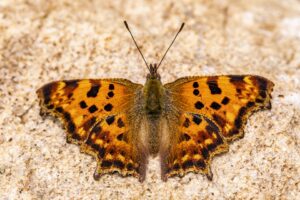Eastern Comma Butterfly Lifecycle

The eastern comma butterfly is a North American butterfly in the family Nymphalidae, subfamily Nymphalinae, this butterfly can be identified by its orange-brown color and dark markings along with a large white mark along its back towards its rear end. Their color makes them inconspicuous to predators camouflaging among other plants. These butterflies are common throughout England and Wales, Ireland, and Southern Scotland.
Their natural habitat includes near rivers, woodland edges, gardens, meadows, forest clearing, and sunny areas. The comma butterfly has a short life span and therefore they make the best of it living anywhere from twenty days to about a month.
If you spot this butterfly in your neighborhood and would love for them to visit your garden then here is what you should do to make your garden a habitat attracting them like a magnet.
Plants that attract the eastern comma butterfly
The adult comma butterfly requires a food source in order to attract them to your garden some of these food sources (garden plants) include nectar-producing plants which include knapweed, violets, clovers, and thistle. They also collect nectar in autumn from flowering bramble storing up energy for hibernation. They can also be seen in urban gardens during late summer feeding on fallen fruits such as plums and apples.
Mating habits of the comma butterfly
It’s interesting when you consider how the mating rituals of these butterflies are carried out, during the mating period the female will mate with several males. The reason for this is to ensure that she receives enough sperm to fertilize her eggs, once the time comes for her to lay her eggs she looks for host plants such as stinging nettles, hops, willow, currant, and elm host plants of the comma caterpillars.
The eggs are laid singly or in small groups of 2 or 3 on the upper side edge of the leaves, the eggs are green and spherical but will eventually turn yellow and then grey before hatching. The eggs will hatch in about 5 days.
Identifying the comma caterpillar
The caterpillar is mainly brown and black with a large white marking along its back and towards its rear end, it is also covered in many-branched spikes. Once the caterpillar hatches it begins to consume the leaves of the host plants they were laid on, they remain at this stage which is also larval for 3 to 4 weeks.
The chrysalis or pupa stage
The pupa stage lasts from 7 to 18 days, during this time the chrysalis hangs upside from trees mimicking dead foliage. The colors are green and pinkish-brown with gold and silver spots.
Adult butterfly
After 2 weeks period passes a beautiful butterfly emerges to repeat its short but exciting cycle again that lasts from 20 days to about a month. This journey is short but at least they live long enough to enjoy their time here impacting our ecosystem before they pass on.
The final word on the eastern comma butterfly
Attracting the eastern comma butterfly to your garden is that simple, help them along their short journey as you create a habitat that will attract them like a magnet. You will be so happy with the results as your garden becomes a wildlife garden, what a great way to give nature a helping hand, and the rewards will be to see the complete lifecycle of these butterflies from your home garden which in my opinion is so cool.
About the author
Norman loves being in the garden, both at home and for his job....
he is 'Natures Little helper' being outdoors, growing his vegetables and flowers from an early age.
Now having spent over 22 years in the profession he want to give some of his knowledge to others...
his vast array of hints and tips you will find scattered over this site will help you no end growing plants in your garden.

Hi Norman. Thank you for very interesting article. I love spending time in garden but I never thought that its so easy to attract butterflies. These are beautiful animals and I would love to see them more. Looking on your post its enough to have proper plants like violets or clovers. Looking forward to test your advices in practice.
Hello butterflies are very beautiful and can bring much excitment for adults especially kids. I am so happy to help. Wishing you success in seeking to get butterflies to your garden.
Thanks for sharing the interesting facts about easter comma butterflies. I hadn’t heard of this specific type of butterfly before, but it is so pretty! We’d love to see them in our garden!! We see a handful of butterflies each year, and based on what you mention that might attract them, I’m guessing it might be the clover that gets their attention. I may try adding violets or thistle to see even more!
The presence of butterflies in a garden is really amazing, it is so good to hear that you are having some that are already visiting your garden and I hope you can attract the eastern comma butterfly as well. I am so happy to help and please let me know how it goes.